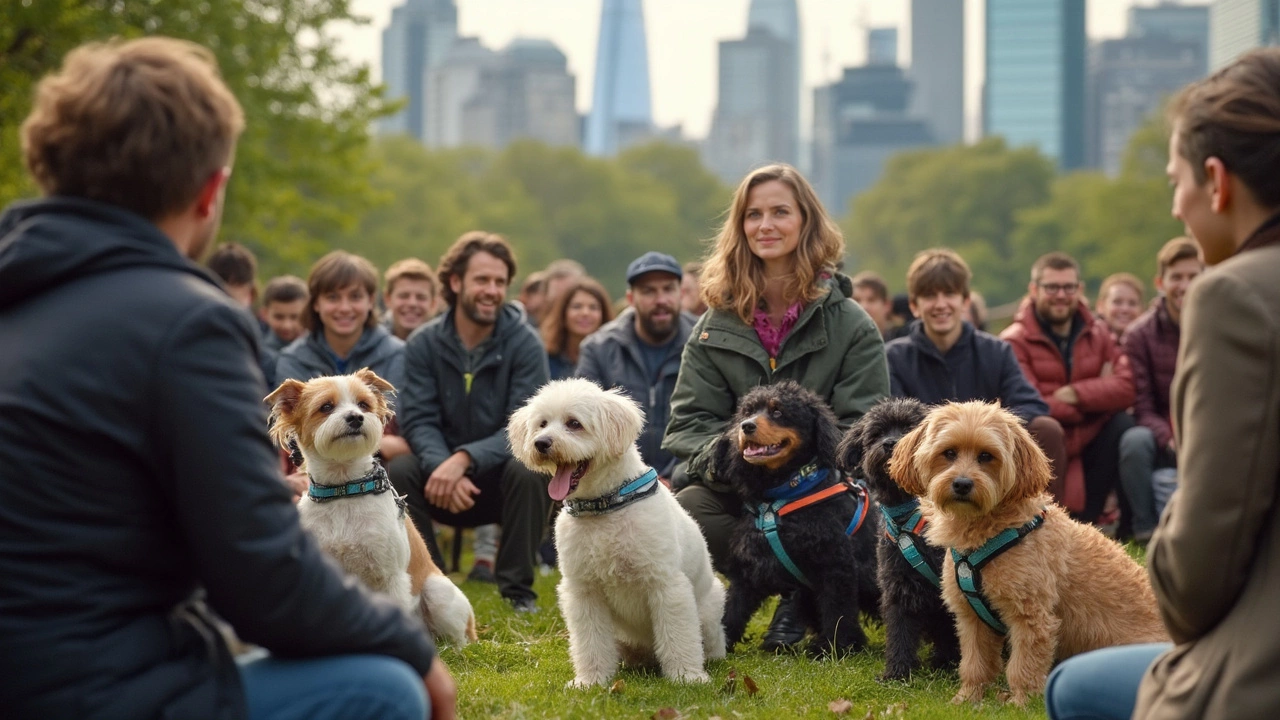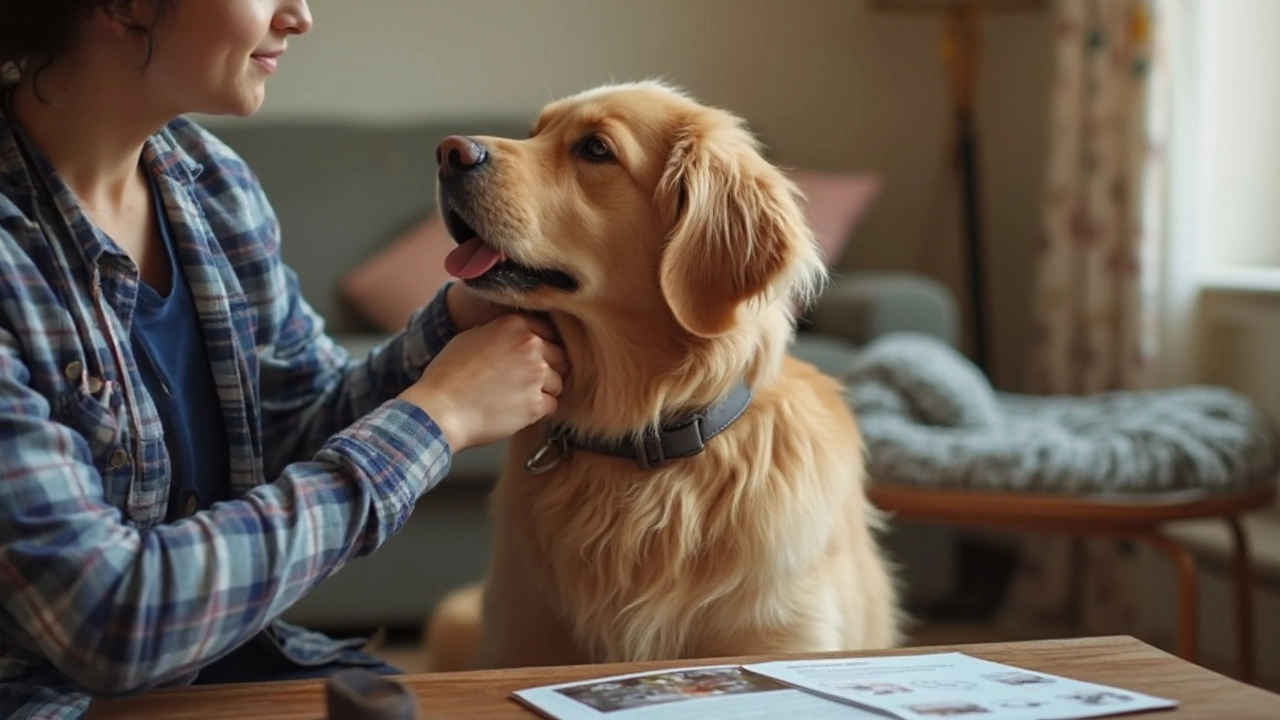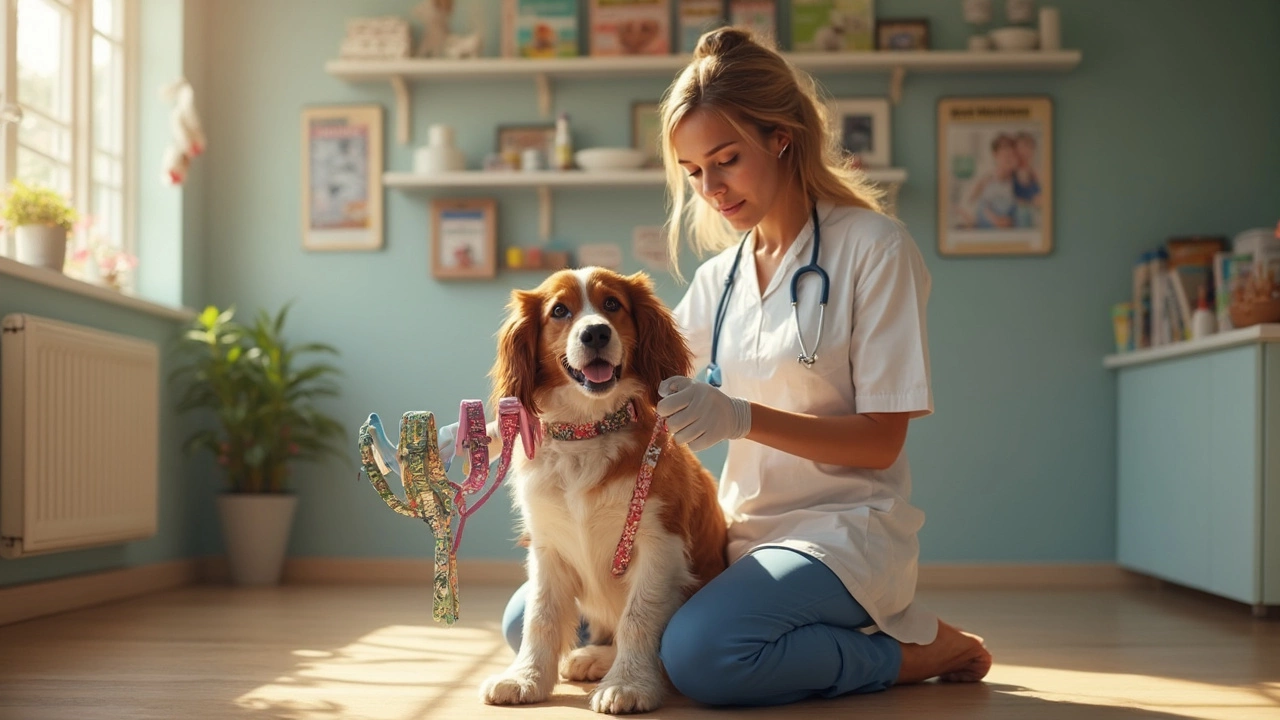Ask any vet, and you'll never get a simple yes or no about dog collars. It's way more complicated than just snapping one on and calling it a day. Sure, collars are everywhere—you see them at the park, in every pet store, on every cute dog TikTok. But have you ever stopped to wonder what your vet would really say about them?
The truth is, collars do way more than just hold a tag with your phone number. They keep your dog safe, help you walk them, and sometimes even tell the world a little bit about their personality. But, and this is a big one, not all collars are a great fit for every dog or every situation. Vets have some strong opinions here—and they're backed up by years of seeing what can go wrong when people pick the wrong gear.
If you want the short version: most vets are fine with regular flat collars for everyday use, like walking around the yard or popping on an ID tag. But when it comes to walking, especially for dogs that pull, some vets recommend a harness to keep your dog's throat safe. We'll get into why—and what else you need to know—coming up.
- Why Collars Are Still Popular
- Real Vet Advice: What Do They Say?
- Collars vs. Harnesses: Which Wins?
- Risks and Precautions
- Tips for Using Collars Safely
Why Collars Are Still Popular
Ask almost any dog owner, and they'll tell you a dog collar is just part of the routine. It’s how we hang onto leashes, show off cute tags, and make sure our pets don’t end up lost and anonymous. Collars have been around forever for a reason—they’re simple, easy, and they work for most dogs.
One big reason dog collars are everywhere? Identification. If your dog slips out the door or hops a fence, that collar tag is the fastest ticket home. Recent info from the American Humane Association says only about 15% of lost dogs without any ID tags get back to their families, but over 90% return home when they have collars and tags. Pretty wild, right?
Besides ID, collars are practical for daily stuff. You can snap a leash on in seconds, which is way easier than wrestling your dog into a harness when you're in a rush. Plus, collars are way less bulky—no one wants their dog to look miserable or get chafed during quick trips outside.
There’s also the training angle. While some styles (like choke or prong collars) are absolutely not recommended anymore, a plain flat collar can help teach basic manners or let you grab hold in a pinch. Vets say the modern, flat version is the safest bet for most everyday purposes.
And let’s be honest, collars are part style, part function. You can pick colors, patterns, even match your dog's vibe to your own. People treat collars almost like doggie accessories, but as long as your dog is comfy, why not?
- Easy to put on and take off
- Keep ID tags and contact numbers visible
- Lightweight and comfy for most dogs
- Handy for leashing up quickly
- Lots of styles for every size and breed
So, whether you’re just walking around the block or heading out on an adventure, standard collars stick around because they make things easier—for you and your dog. But remember, vets still want you to pick one that’s safe and fits right. More on that soon.
Real Vet Advice: What Do They Say?
So, what’s the real story behind what vets think about dog collars? It’s not a one-size-fits-all answer, but there’s a pretty clear consensus for a lot of situations. Most vets are on board with using simple, flat collars for holding ID tags. That’s because having clear ID information is still one of the fastest ways to get your pup back if they ever go missing. In fact, the American Veterinary Medical Association has said that proper identification on a dog collar is critical for pet recovery.
Where things get interesting is when you use collars for walks, training, or behavior correction. Nearly every vet I’ve ever spoken to has said the exact same thing: avoid choke chains and prong collars. These old-school tools can cause throat injuries, increase anxiety, and even lead to long-term health problems. Instead, most vets lean towards harnesses for dogs that pull, have tiny necks, or any breathing problems—like pugs or bulldogs.
If you’re asking about those fancy GPS or flea collars, vets will usually say they’re okay, but only if you follow the instructions to the letter. Fit matters a lot. Too loose, and the collar’s pointless. Too tight, and you risk choking or skin irritation. Recent numbers show that nearly 30% of vet visits for collar-related harm in the U.S. are due to collars being way too tight or not checked as the dog grows.
| Collar Type | Vet Recommended? | Common Issues |
|---|---|---|
| Flat Collar | Yes (for ID tags, casual use) | Neck injuries if dog pulls hard |
| Harness | Yes (for walks & pullers) | Can chafe if not fitted right |
| Prong/Choke | No | High risk of injury, stress |
| Martingale | Sometimes (for escape artists) | Needs proper fit |
Bottom line—if your pup is chill on leash, vets won’t complain about basic dog collars. But if you’ve got a puller, a breed with a short neck, or a dog with breathing issues, most pros say ditch the collar and grab a harness. This isn’t about style; it’s about being practical and keeping your dog safe. And if you’re not sure what’s best for your dog’s breed or behavior, your vet is always happy to walk you through your options (trust me, they’d rather answer questions than treat a preventable neck injury later).

Collars vs. Harnesses: Which Wins?
So, let's put dog collars and harnesses head-to-head. People argue about this all the time at the dog park, and, honest truth, there's no single answer for every pup. Vets usually agree: the best choice depends on your dog's size, behavior, and neck shape.
Collars are the classic pick. They're easy to put on, and you can attach your dog's ID right away, which is huge for safety. For calm dogs who don't pull, a regular flat collar usually works just fine—especially for short strolls or just hanging out in the backyard.
But here's the thing about collars: if your dog is a master puller, has a skinny neck, or gets excited on walks, collars can actually put a lot of pressure on their throat. And that can lead to coughing, gagging, or even long-term damage in some cases. One interesting stat: a 2020 survey of US vets found that over 60% recommend harnesses for dogs with tracheal or neck issues.
| Feature | Collar | Harness |
|---|---|---|
| Easy to put on | ✔️ | ✔️ |
| Controls pulling | ❌ | ✔️ |
| Keeps ID tags visible | ✔️ | ✅ |
| Reduces neck strain | ❌ | ✔️ |
| Works for training | ⚠️ (depends) | ✔️ |
Harnesses are kind of the new kid on the block but for good reason. They spread pressure across your dog's chest and back instead of the neck. This is especially helpful for small breeds, dogs with breathing issues, or those who pull like they're training for a sled race. I switched my own dog to a harness after Gavin noticed he was coughing on walks—it made a huge difference.
Just keep in mind, harnesses aren't perfect for everything. Some dogs find them annoying at first, and if they're not adjusted right, they can chafe or rub. Plus, collars still win when it comes to holding ID tags—you really want that backup if your dog ever bolts out the door.
- If your dog pulls or has any throat issues, go harness.
- If you're just out for potty breaks or hanging around the house, a collar is usually just fine.
- For most dogs, using both—a collar for ID and a harness for walks—makes a great combo.
Still unsure? It's totally okay to ask your vet which works best for your dog. No shame in wanting your four-legged buddy to be comfy and safe out there.
Risks and Precautions
If you’re thinking dog collars are always safe, think again. Vets see all kinds of collar-related issues, and some of them are serious. A big one is neck injuries. Dogs that pull on the leash, especially strong or excitable dogs, can hurt themselves pretty fast. Collars press right on the windpipe. Over time, this can lead to coughing, tracheal collapse, or even nerve damage. Tiny breeds and dogs with thin necks like Italian Greyhounds are especially at risk.
Skin problems crop up often, too. Collars that are too tight can rub, creating sores or even causing hair loss right around your dog’s neck. If you leave a collar on a fast-growing puppy, that’s a recipe for trouble. And, let’s be honest, not everyone remembers to check collar fit as dogs grow or lose weight.
Believe it or not, collars can get snagged. Dogs have caught theirs on radiator grates, fence posts, and crate bars more often than you'd think. This can lead to panic, choking, or worse if no one’s around to help.
- Always check the collar fit—you should be able to slip two fingers between your pup’s neck and the collar. Too loose and it might slip off, too tight and it can cause injury.
- If you use a narrow or chain type collar, be extra careful. Choke and prong collars can ramp up the risk of throat and skin injuries. Vets usually don’t recommend them unless you’re working with a professional trainer.
- Think twice before leaving a collar on a dog when they’re unsupervised—especially during crate time or group play—since accidents can happen fast.
- Changes in your dog’s weight, coat, or skin mean you should check that collar again. Sometimes you don’t notice the changes until it’s too late.
Check out this table showing common collar-related problems vets see and when:
| Problem | When It Happens | Who’s Most at Risk |
|---|---|---|
| Neck Injuries | Pulling on leash, using choke or prong collars | Strong pullers, small breeds |
| Skin Irritation | Dirty/wet collars, poor fit, growing puppies | Long-haired breeds, puppies |
| Choking/Snagging | Crate time, playtime | Puppies, playful dogs |
Bottom line: collars aren’t bad, but ignoring these risks can seriously hurt your dog. Safe use is about common sense—keep a close eye on fit, material, and your dog’s behavior. If something seems off, take it off and ask your vet. It’s always better to be safe.

Tips for Using Collars Safely
Using dog collars the right way means you’re thinking about your pup’s health and comfort. Vets have seen just about every collar mistake out there, so learning from their experience makes a world of difference. Getting this part right isn’t just about looks. It’s about everyday safety.
First, always make sure the collar fits. The golden rule? You should be able to slip two fingers—side by side—under the collar. Too tight, and you’re risking rubbing, choking, or skin infections. Too loose, and your escape artist dog might back out during a walk. Regularly check fit, especially on puppies, because they grow fast and that perfect fit won’t last long.
Go for flat, non-slip collars for everyday wear. If you’re using training collars like chokers or prongs, know that most vets are wary of them because they can damage a dog’s throat or neck, especially small breeds. Stick to regular collars for ID tags and opt for a harness if your dog pulls on the leash. Fun fact—studies show harnesses cut neck injuries in pulling dogs by up to half compared to collars alone.
Don’t leave collars on 24/7. If your dog is unsupervised, take it off to lower the risk of snagging on furniture or crates. I’ve heard stories at the vet clinic about collars getting caught while pups are playing, which sometimes causes panic or injury.
- Check for skin irritation, hair loss, or any marks on the neck every week.
- Clean the collar regularly (yep, they get stinky, and bacteria love that).
- Update ID tags if your contact info changes—nobody wants a lost dog with old details.
- Swap out worn or stretched collars. Fraying means it’s time for a new one.
And let’s not forget: each pet health check at the vet is a good time to ask if your dog’s collar is still working for them. Your vet isn’t judging your style—just making sure your dog is comfy and safe.
